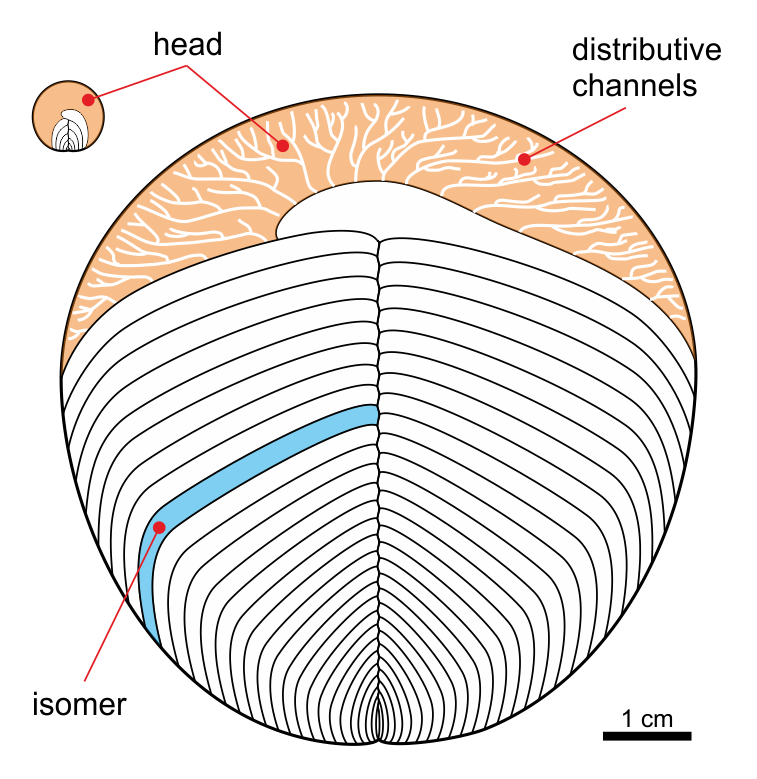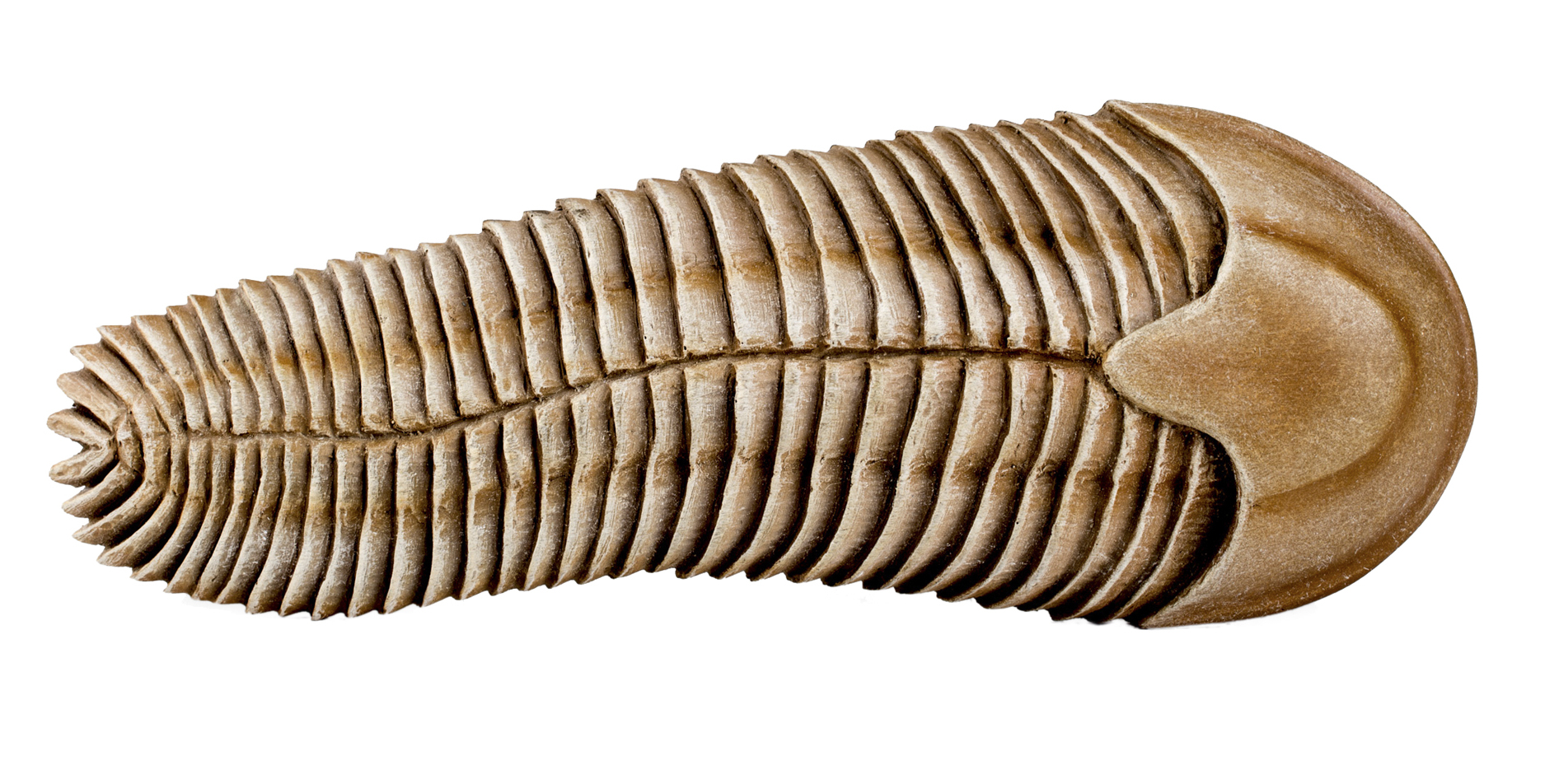|
Sprigginidae
Sprigginidae is an extinct family of the class Cephalozoa, characterized by having a greater number of isomers than its sister taxon, Yorgiidae. They lived approximately 635 million years ago, in the Ediacaran period. Description Like most members of Proarticulata, their body plan consists of isomers arranged in a glide symmetry, meaning they do not have true bilateral symmetry, although what sets them out from other proarticulates is their greater number of isomers, numbering up to around 40, sometimes more, overall. They also have a distinct 'horseshoe' shaped 'head'. When the first member of the family, ''Spriggina'', was discovered, it was considered to be a polychaete annelid, and petalonamid frond, and even an arthropod, with probable relations to trilobites. Although most recent studies now agree that ''Spriggina'', and the family its apart of, are apart of the phylum Proarticulata. Distribution Most genera are restricted to sediments within the Flinders Ranges of Sou ... [...More Info...] [...Related Items...] OR: [Wikipedia] [Google] [Baidu] |
Cephalozoa
Cephalozoa are an extinct class (biology), class of primitive segmented marine organisms within the Phylum (biology), Phylum Proarticulata from the Ediacaran period. They possessed bilateral symmetry and were characterized by a thin, rounded body. Description Unlike the other classes of proarticulata, proarticulates, the segmentation of the body is not complete and shows a "head" with fine distribution channels. Some species of the Yorgiidae family also show some asymmetry. They were discovered in Russia near the White Sea in the Arkhangelsk region, where they lived during the Ediacaran, approximately 635 to 540 myr, Ma (millions of years ago). Taxonomy Cephalozoa includes the families Yorgiidae and Sprigginidae: Yorgiidae *† ''Archaeaspinus'' Ivantsov, 2007 (synonym of ''Archaeaspis'') **† ''Archaeaspinus fedonkini'' Ivantsov, 2001 *† ''Yorgia'' Ivantsov, 1999 **† ''Yorgia waggoneri'' Ivantsov, 1999 Sprigginidae *† ''Spriggina'' Glaessner, 1958 **† ''Spriggina fl ... [...More Info...] [...Related Items...] OR: [Wikipedia] [Google] [Baidu] |
Praecambridium Sigillum
''Praecambridium sigillum'' is an extinct organism that superficially resembles a segmented trilobite-like arthropod. It was originally described as being a trilobite-like arthropod, though the majority of experts now place it within the Proarticulata as a close relative of the much larger ''Yorgia''. It is from the Late Ediacaran deposit of Ediacara Hills, Australia, about 555 million years ago. On average, ''P. sigillum'' had at least 5 pairs of segments, with each unit becoming progressively larger as they approach the cephalon-like head. Etymology The generic name is a compound word, with the Latin prefix ''prae'' "before" and a reference to the Cambrian mollusc genus '' Cambridium'', in reference to how the appearance of the various segments are reminiscent of the muscle-scars on the inner surface of the shells of '' Cambridium''. The specific name is from Latin ''sigillum'' "a sigil". Classification and interpretations Originally, Runnegar and M.A. Fedokin (1992) suggested ... [...More Info...] [...Related Items...] OR: [Wikipedia] [Google] [Baidu] |
Yorgiidae
Yorgiidae is an extinct family of the class Cephalozoa, which is a part of the wider phylum Proarticulata. They lived from around 571 to 551 Ma. Description Like other relatives within the phylum Proarticulata, their body plan consists of isomers arranged in a glide symmetry, meaning they do not have true bilateral symmetry. As with other cephalozoans, their initial right isomer extends right across the body, forming a distinctive 'head', whilst they have a unique feature with their initial left isomer extending slightly to the right side and into the initial right isomer. This is most prominent in the genus ''Archaeaspinus'', with it having an unpaired left lobe/isomer within its 'head' region, forming a distinctive question mark-like shape. Distribution Genera of the family Yorgiidae are most commonly found in the Ust' Pinega Formation and Central Urals of Russia, as well as the Flinders Ranges of South Australia. Taxonomy Yorgiidae includes the following genera: *� ... [...More Info...] [...Related Items...] OR: [Wikipedia] [Google] [Baidu] |
Praecambridium
''Praecambridium sigillum'' is an extinct organism that superficially resembles a segmented trilobite-like arthropod. It was originally described as being a trilobite-like arthropod, though the majority of experts now place it within the Proarticulata as a close relative of the much larger ''Yorgia''. It is from the Late Ediacaran deposit of Ediacara Hills, Australia, about 555 million years ago. On average, ''P. sigillum'' had at least 5 pairs of segments, with each unit becoming progressively larger as they approach the cephalon-like head. Etymology The generic name is a compound word, with the Latin prefix ''prae'' "before" and a reference to the Cambrian mollusc genus '' Cambridium'', in reference to how the appearance of the various segments are reminiscent of the muscle-scars on the inner surface of the shells of '' Cambridium''. The specific name is from Latin ''sigillum'' "a sigil". Classification and interpretations Originally, Runnegar and M.A. Fedokin (1992) suggested ... [...More Info...] [...Related Items...] OR: [Wikipedia] [Google] [Baidu] |
Cyanorus Singularis
''Cyanorus singularis'' is a small proarticulatan, closely related to ''Spriggina'' and ''Marywadea''. The anterior part of the body was most likely not segmented. The axial structure of it combines features of the ''Vendia'' species and ''Dickinsonia'' species. It was found in the Upper Vendian of the White Sea area, Arkhangel'sk Region. It is a White Sea Ediacaran fossil and it became extinct during the Late Precambrian. Like other animals from the phylum Proarticulata, the symmetry observed is not exactly bilaterian but appears to be a glide reflection In geometry, a glide reflection or transflection is a geometric transformation that consists of a reflection across a hyperplane and a translation ("glide") in a direction parallel to that hyperplane, combined into a single transformation. Bec ..., where opposite segments are shifted by half an interval. Notes References {{Taxonbar, from=Q60760937 Ediacaran life Sprigginidae ... [...More Info...] [...Related Items...] OR: [Wikipedia] [Google] [Baidu] |
Spriggina
''Spriggina'' is a genus of early animals whose relationship to living animals is unclear. Fossils of ''Spriggina'' are known from the late Ediacaran period in what is now South Australia. ''Spriggina floundersi'' is the official fossil emblem of South Australia; it has been found nowhere else. The organism reached in length and may have been predation, predatory. Its bottom was covered with two rows of tough interlocking plates, while one row covered its top; its front few segments fused to form a "head." The affinity of ''Spriggina'' is unknown; it has been variously classified as an annelid worm, a rangeomorph-like frond, a variant of ''Charniodiscus'', a proarticulatan, an arthropod (perhaps related to the trilobites), or even an extinct phylum. The lack of known segmented legs or limbs, coupled with the presence of glide reflection instead of symmetry, symmetric segments, suggests that an arthropod classification is unlikely despite some superficial resemblance. The genu ... [...More Info...] [...Related Items...] OR: [Wikipedia] [Google] [Baidu] |
Marywadea Ovata
''Marywadea'' is a genus of Ediacaran biota shaped like an oval with a central ridge. It is a bilaterian organism as evidenced by its symmetry, vaguely resembling a very primitive trilobite. The fossil has an asymmetrical first chamber of the quilt. It has transverse ridges away from the central axis that may be gonads. The head is shaped as a semicircle and is the same width as the rest of the body. The ridges number about 50. There are two oval shapes below the head. ''Marywadea ovata'' is the only described species of the genus. Originally ''M. ovata'' was grouped under the genus ''Spriggina'', but later research moved the species into its own genus. It is most often interpreted as an early arthropod, annelid, or a member of Proarticulata, but as with all Ediacarian fauna its phylogeny remains uncertain. Initially, it was described as the second species of ''Spriggina''. The genus was established by Martin Glaessner in 1976, who named it after fellow paleontologist Mary Wade, ... [...More Info...] [...Related Items...] OR: [Wikipedia] [Google] [Baidu] |
Marywadea
''Marywadea'' is a genus of Ediacaran biota shaped like an oval with a central ridge. It is a bilaterian organism as evidenced by its symmetry, vaguely resembling a very primitive trilobite. The fossil has an asymmetrical first chamber of the quilt. It has transverse ridges away from the central axis that may be gonads. The head is shaped as a semicircle and is the same width as the rest of the body. The ridges number about 50. There are two oval shapes below the head. ''Marywadea ovata'' is the only described species of the genus. Originally ''M. ovata'' was grouped under the genus '' Spriggina'', but later research moved the species into its own genus. It is most often interpreted as an early arthropod, annelid, or a member of Proarticulata, but as with all Ediacarian fauna its phylogeny remains uncertain. Initially, it was described as the second species of '' Spriggina''. The genus was established by Martin Glaessner in 1976, who named it after fellow paleontologist Mary ... [...More Info...] [...Related Items...] OR: [Wikipedia] [Google] [Baidu] |
Spriggina Floundersi
''Spriggina'' is a genus of early animals whose relationship to living animals is unclear. Fossils of ''Spriggina'' are known from the late Ediacaran period in what is now South Australia. ''Spriggina floundersi'' is the official fossil emblem of South Australia; it has been found nowhere else. The organism reached in length and may have been predation, predatory. Its bottom was covered with two rows of tough interlocking plates, while one row covered its top; its front few segments fused to form a "head." The affinity of ''Spriggina'' is unknown; it has been variously classified as an annelid worm, a rangeomorph-like frond, a variant of ''Charniodiscus'', a proarticulatan, an arthropod (perhaps related to the trilobites), or even an extinct phylum. The lack of known segmented legs or limbs, coupled with the presence of glide reflection instead of symmetry, symmetric segments, suggests that an arthropod classification is unlikely despite some superficial resemblance. The genu ... [...More Info...] [...Related Items...] OR: [Wikipedia] [Google] [Baidu] |


